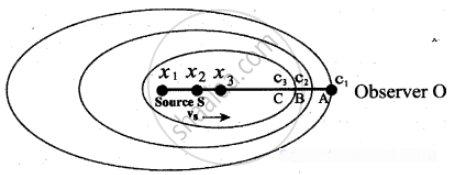Advertisements
Advertisements
प्रश्न
Discuss the following case:
Source in motion and Observer at rest
- Source moves towards observer
- Source moves away from the observer
उत्तर
(a) Source moves towards die observer-

Source S moves towards an observer O (right) with velocity
Suppose a source S moves to the right (as shown in Figure) with a velocity vs and let the frequency of the sound waves produced by the source be fs. It is assumed that the velocity of sound in a medium is v.
Suppose a source S moves to the right (as shown in Figure) with a velocity vs and let the frequency of the sound waves produced by the source be fs. It is assumed that the velocity of sound in a medium is v.
The compression (sound wavefront) produced by the source S at three successive instants of time are shown in the Figure. When S is at position x1 the compression is at C1. When S is at position x2, the compression is at C2 and similarly for x3 and C3.
It is meant that the wavelength decreases when the source S moves towards the observer O. But frequency is inversely related to wavelength and therefore, frequency increases.
Calculation:
Let λ be the wavelength of the source S as measured by the observer when S is at position x1 and λ’ be the wavelength of the source observed by the observer when S moves to position x2.
Then the change in wavelength is ∆λ = λ – λ’ = vst, where t is the time taken by the source to travel between x1 and x2 Therefore,
λ’ = λ – vst … (1)
But t = \[\frac{λ}{v}\] … (2)
On substituting equations (2) in equation (1), we get.
`lambda' = lambda(1 - "v"_"s"/"v")`
Since frequency is inversely proportional to wavelength, we have
`"f"' = "v"_"s"/(lambda')` and f = `"v"_"s"/lambda`
Hence `"f"' = "f"/((1 - "v"_"s"/"v"))` ...(3)
Since, `"v"_"s"/"v"` << 1, by using the binomial expansion and retaining only first order in `"v"_"s"/"v"`, we get
`"f"' = "f"(1 + "v"_"s"/"v")` ...(4)
(b) Source moves away from the observer-
Since the velocity of the source is opposite in direction when compared to case (a), hence by changing the sign of the velocity of the source in the above case i.e., by substituting (vs → – v ) in equation (1), we get
`"f"' = "f"/((1 + "v"_"s"/"v"))` ....(5)
Using binomial expansion again, we get
`"f"' = "f"(1 - "v"_"s"/"v")` .....(6)
APPEARS IN
संबंधित प्रश्न
In discussing Doppler effect, we use the word "apparent frequency". Does it mean that the frequency of the sound is still that of the source and it is some physiological phenomenon in the listener's ear that gives rise to Doppler effect? Think for the observer approaching the source and for the source approaching the observer.
Answer briefly.
State the expression for apparent frequency when source of sound and listener are
- moving towards each other
- moving away from each other
How do animals sense impending danger of hurricane?
If a star appearing yellow starts accelerating towards the earth, its colour appears to be turned ______.
The difference between the apparent frequency of a stationary source of sound as perceived by the observer during its approach and recession is 2% of the frequency of the source. If the speed of sound in air is 300 ms–1, then the velocity of the observer is
A train moving at 25 m/s emits a whistle of frequency 200 Hz. If the speed of sound in air is 340 m/s, find the frequency observed by a stationary observer.
- if the observer is in front of the source.
- if the observer is behind the train.
When a sound source of frequency n is approaching a stationary observer with velocity u than the apparent change in frequency is Δn1 and when the same source is receding with velocity u from the stationary observer than the apparent change in frequency is Δn2. Then ______.
A racing car moving towards a cliff sounds its horn. The sound reflected from the cliff has a pitch one octave higher than the actual sound of the horn. If V is the velocity of sound, the velocity of the car is ______.
The frequency of echo will be ______ Hz if the train blowing a whistle of frequency 320 Hz is moving with a velocity of 36 km/h towards a hill from which an echo is heard by the train driver. The velocity of sound in air is 330 m/s.
A whistle producing sound waves of frequencies 9500 Hz and above is approaching a stationary person with speed v ms-1. The velocity of sound in air is 300 ms-1. If the person can hear frequencies up to a maximum of 10,000 HZ, the maximum value of v up to which he can hear the whistle is ______.
